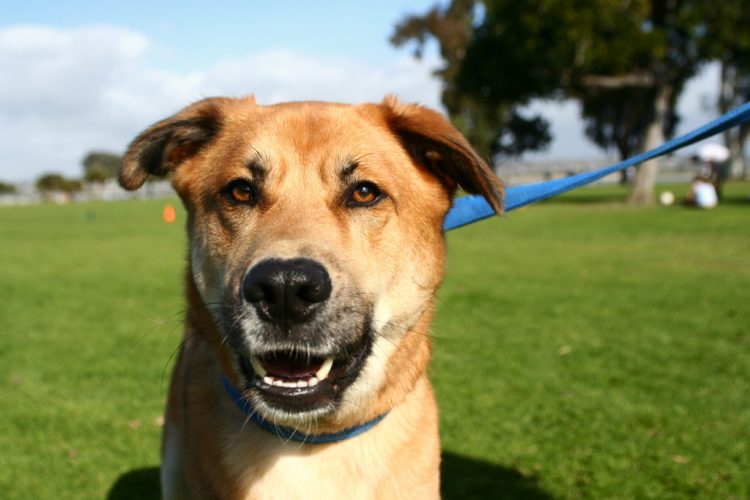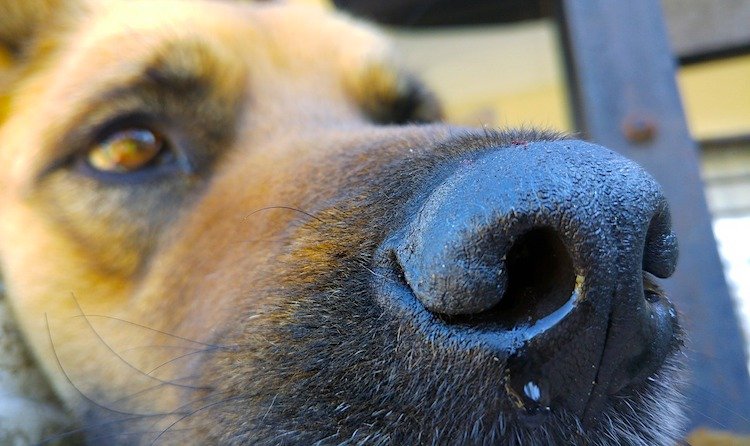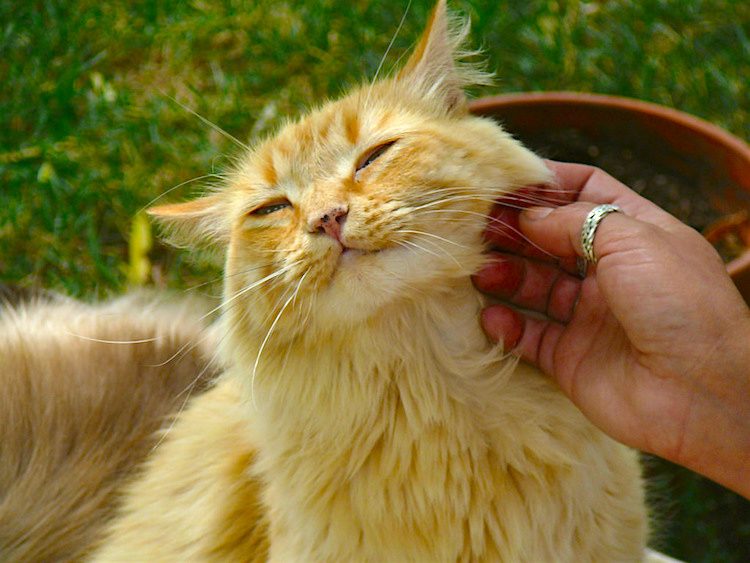
When our pets are sick, our mind often trips into worst-case-scenario mode: Does my dog have cancer?
Despite all my training as a veterinarian, I did this, too, when one of my own cats went lame.
My mind immediately screamed, “He might have bone cancer!” rather than the more likely alternative that my cat was in a fight (which was the case).
Part 1: Does My Dog Have Cancer?
When a pet isn’t well, vets often run blood tests.
When we say that test results are normal or negative, commonly the person will let out a breath and say, “So my dog doesn’t have cancer.”
Well, we don’t know that because routine blood panels don’t diagnose cancer. Sure, we can get clues, but that’s often as far as screening tests go.
First, We Get a Medical History
It starts with gathering information about the pet with a history and a physical exam, paying particular attention to:
- General body condition
- Gum color
- Organ texture and size
- Skin lumps and bumps
- Unexplained changes in toilet habits
As well as building a general picture of the animal’s health, this can suggest problems other than cancer that need investigating.
The vet then uses this information to run specific tests and reach a diagnosis.
Blood Tests Don’t Actually Look for Cancer
For many pets with cancer, a routine blood test comes back normal. Why is this?
Quite simply, the test isn’t looking for cancer. It measures how well the organs function, electrolyte levels, and the size and number of red and white cells.
OK, there are blood cancers such as leukemia or some lymphomas that shift the white cell count, but these are the exception rather than the rule.
Think of it like a car mechanic diagnosing why a vehicle drives rough:
- If he just looked at the engine and found no problem, it doesn’t mean the vehicle is fine.
- That’s because the mechanic didn’t spot that one of the tires was flat.
In just the same way, cancers often have a local effect that doesn’t show up in general blood tests.

The Purpose of Screening Tests
The thirsty cat who’s losing weight needs blood tests so that common problems, such as overactive thyroids, diabetes or kidney disease, aren’t missed.
When these don’t provide the answer, the suspicion of cancer rises. Also, there are 2 examples where clues to cancer do show up in the blood:
- Blood cancers, where too many of one type of blood cell are produced
- Bone marrow cancer, where too few of certain blood cell types are produced
My Pet Has a Lump
When there’s a skin lump present, taking a sample of cells for analysis is ideal. This could be just a few cells (through a needle) or the whole lump (by removing it).
Was YOUR Pet Food Recalled?
Check Now: Blue Buffalo • Science Diet • Purina • Wellness • 4health • Canine Carry Outs • Friskies • Taste of the Wild • See 200+ more brands…

Common procedures include:
- Fine needle aspirate: A few cells are sucked up via a needle and syringe. This is noninvasive, doesn’t require an anesthetic and gives a rapid diagnosis for some cancers.
- Biopsy: This is a surgical procedure to remove a small tissue sample. This requires sedation and local anesthetic.
- Excisional biopsy: This is where the surgeon removes the whole lump, which is sent for analysis.
Next Steps When We Suspect Cancer in a Dog or Cat
When a pet is sick but there’s no external lump, the vet’s next step is imaging.
With radiography, ultrasound or a CT or MRI scan, a clinician can see what’s going on inside.
Each method has advantages and disadvantages:
- X-rays: Good for looking at bones and air-filled structures, such as the lungs, but not so great for soft tissue, such as the gut.
- Ultrasound: Gives great pictures of organs such as the liver, kidneys, bowel, bladder and heart.
- MRI or CT scan: Super-detailed slice through sections of the body. Helpful for pre-surgical planning if the pet has a tumor.
In some cases, the vet will perform an exploratory operation to investigate what’s going on internally.
A New Blood Test for Cancer in Pets?
In the United States, there’s now a blood test that looks at markers released in the bloodstream when cells multiply too quickly, as with cancer. Ask your vet about it.
Unfortunately, even this test isn’t perfect, because slow-growing cancers can be missed, and the test gives a “yes-no-maybe” answer rather than pinning down the type and location.
So X-rays or an ultrasound scan will still be necessary if the result is positive.
And finally, cancer caught early is often treatable. If you’re concerned about your pet, then have your vet check them over sooner rather than later.

Part 2: Early Warning Signs of Cancer in a Dog or Cat
It’s never a topic any of us like thinking about — the big “C,” cancer. Most of us have probably been touched by it in some way or another in our lives.
There are varying degrees and progressions of cancer, and early discovery with most cancers goes a long way toward a successful recovery.
Here are some of the signs of cancer in a dog or cat:
1. Suspicious Lumps or Bumps
We hear a lot about women giving themselves regular breast exams and checks, but you never really hear about checking your pet.
When you’re engaged in playtime or just patting time, run your hands over your pet just to get the lay of the land.
If you encounter a lump that you haven’t felt or seen before, it’s probably not a bad idea to get it checked out by the vet. Chances are it’s nothing — but as they say, better safe than sorry.
2. Strange, Off-putting Odors
Every once in a while your dog is going to let out some gas, sure, and it is never pleasant.
But if you notice a persistent odor around the mouth, ears or anal areas, it is time to get that checked out. Some cancers cause foul odors.
3. Unexplained Discharge
Pus, blood or anything out of the ordinary should be looked into immediately. After all, blood comes from somewhere and if you can’t see where your pet is bleeding from, there may be internal bleeding.
Pus can signify an infection or may be a sign of something more serious.
4. Persistent Wounds
This could be a sign of an infection or skin disease, but it could also be cancer. Most superficial wounds heal within a week or so, but if your dog or cat has a wound that just isn’t healing, get it checked out.
5. Unexplained Weight Changes
Sometimes your pet is just pudgy and you have to put them on a diet. It happens to a lot of us, but if your pet is losing weight and you haven’t changed the diet, that is something to look into.
Many cancers can cause dramatic weight loss in both people and pets.
6. Appetite Changes
Feeling ill can put many pets off food, but a persistent disinterest in feeding time is something to ask your vet about. Another thing to watch for is increased thirst.
7. Coughing or Difficulty Breathing
As with the other signs on this list, it’s difficult to point at a symptom and say, “That’s cancer!” with any certainty.
Many things can cause coughing and/or breathing problems: Colds, kennel cough and aspiration pneumonia are just a few illnesses that can cause this symptom.
However, some lung cancers and tumors can manifest in these symptoms. Difficult respiration should be cause for concern.
8. Sudden Lethargy or Depression
Pets have feelings, and if they seem downcast day after day there may be something going on inside them that you can’t see.
If they have cancer, a great deal of energy is being devoted inside to fighting the disease, and it can cause your pet to seem tired and not interested in doing much more than lying down or sleeping.
9. Unexplained and Persistent Changes in Bathroom Habits
A house-trained pet losing bowel or bladder control occasionally is somewhat common. Being inside too long, drinking too much water, a getting stomach illness could be causes.
Persistently losing control is another matter.
Constant and persistent diarrhea or constipation is a sign of ill health as well. Every animal eats something that doesn’t agree with them in their lifetime, of course — but when bowel or bladder control is lost or sudden stool or urine changes happen with no explanation, that’s definitely worth a mention to the vet.
10. Unexplained Pain
If your pet is limping, showing sensitivity toward a certain area of the body or snapping at you when you go near, your pet may be in pain.
If your pet has pain and you can’t explain it, get it checked out by your vet just to be safe. The hardest thing about diagnosing cancer in a dog or cat is that it manifests in symptoms that are so broad and across the spectrum.
You know your pet better than anyone else. Watch for obvious changes. Don’t be afraid to call your vet and ask for advice, a quick opinion or for your pet to be seen.

Part 3: How to Reduce the Risk of Cancer in Your Dog or Cat
What’s the hardest part of being a pet’s human?
Most people will say it’s the fear of their pets being unwell, or the fear of losing the pet.
Protecting our pets’ health is what de-sexing, de-worming and vaccinations are all about. But can we go further than that? Is there a way to protect our precious fur friends against cancer?
The answer is “Yes, maybe, but no guarantees.”
Causes of Cancer in Pets
To prevent a problem, it’s helpful to recognize the risk factors.
Family History and Inheritance
Some dog breeds carry a higher risk of cancer than others.
This suggests a genetic link to cancer that is passed from susceptible parents to their pups. Unfortunately, this is difficult to prevent because the parents produced litters before they themselves become sick.
Examples of breeds at risk include:
- German Shepherds: They are prone to hemangiosarcoma. This is a tumor that affects highly vascular organs such as the spleen or heart.
- Boxers: Have you heard of the Boxer bump? This is the potentially serious skin cancer called mast cells tumor.
- Bernese Mountain Dogs: It is a sad fact that these beautiful, gentle giants have a high incidence of cancer.
Having one of these breeds does not automatically mean they’ll get cancer, but the odds are slightly higher. If you are “risk averse,” then research the breed first to see what health problems might await.
Age
Getting older goes hand-in-paw with an increased risk of cancer.
It’s thought that an aging immune system is less efficient at policing cell mutations — meaning instead of killing cancer cells, these mutations get a chance to become established.
The upside of this is that our pets are indeed living longer.
Whereas we used to expect our pets to die of renal or heart disease, modern drugs mean pets live longer — allowing age-related problems such as cancer to show up.
Viruses
The classic example is the feline leukemia virus (FeLV) in cats, which causes a variety of cancerous conditions. Happily, an effective vaccine is an option for at-risk cats.
Carcinogens and the Environment
Our pets are just as vulnerable to the harmful effects of carcinogens as people are. For example, pesticides, insecticides, air pollution and asbestos can all make our pets ill.
Avoidance is best policy, which includes tobacco smoke that puts your pet at risk of lung cancer.

How to Reduce the Risk of Cancer in Your Pet
Enough of feeling helpless. Here are some concrete steps can you take to keep your pet well.
De-Sexing Dogs
- Female dogs spayed before their first season have a huge protection against mammary cancer in later life.
- For the boys, neutering eliminates the risk of testicular cancer. However, current evidence is undecided with regard to protecting against prostate cancer.
A Healthy Diet
First, let’s be clear: There is no diet that will prevent cancer in a dog or cat.
However, good nutrition helps feed the body’s immune system and strengthens its defenses.
Antioxidants are particularly important. They eliminate damaging free radicals that cause cell mutations. Providing a vitamin E-rich diet to encourage the breakdown of free radicals is a sensible precaution.
In addition, being picky about the artificial preservatives, colors and flavorings that go into your pet’s mouth is a good way of reducing contact with edible carcinogens.
Reducing Identifiable Risks
A white-coated dog with a pink nose is at risk of sunburn leading to skin cancer. This is a risk because the dog lacks the protective pigment melanin.
If you have a thin-coated or fair-skinned pet, then keep them safe in the sun: Use pet-friendly sunscreen and UV protective T-shirts, and provide plenty of shade.
Also, avoid leaving your pet out in the yard on a hot, sunny day.
Vigilance and Vet Visits
When detected early, most cancers stand a much better chance of treatment and cure.
For example, we can successfully remove most small mast tumors with wide margins when they are spotted early. That same mast tumor, when allowed to grow, may have already seeded cancer cells by the time it goes to surgery.
Check your pet’s body over weekly. Be alert for new lumps and bumps. At the very least, take a photo on your phone and write down the exact size of the lump. Any lump should be checked by a vet.
But if you decide to wait, then it’s essential to monitor things. Check the lump again at weekly intervals, being alert for increased size, redness, change of character or spread.
Here’s a veterinary oncologist’s take on cancer in pets:

Signs Your Pet Should See the Vet
If your cat or dog is diagnosed with cancer, especially when the cancer caught early, there’s a lot that can be done.
The worst decision is to hope the problem goes away on its own and let precious time tick by.
At home, be alert for general signs, such as:
- A growing, changing or angry-looking lump
- A swollen belly
- Difficulty breathing
- A lack of energy or appetite
- Increased thirst
- Lameness or stiffness
- A change in behavior, especially a lack of interest in walks or play
These are all pointers that your pet needs to see a vet. Prompt diagnosis can make all the difference.
I wish I could suggest a cast-iron way to protect your pet against cancer. Sadly, this isn’t possible.
From a good diet to a weekly checkover, simple things do make a difference, so don’t be discouraged — instead, be proactive against cancer.

Part 4: Why Cancer Is Not a Death Sentence for Your Pet
So, what if your veterinarian comes back into the exam room, after looking at an X-ray or an ultrasound, and utters the dreaded sentence, “I think your dog has cancer”?
Many people would be devastated, and rightfully so.
But just as in human medicine, there have been great advances in treating cancer in pets in the past few years.
Although we may not be able to “cure” the cancer, it is possible that surgery, chemotherapy or radiation — or some combination of them — can give your pet a great quality of life for many months or years to come.
Most cancers can go into remission. Some forms of cancer are, indeed, curable.
Chemotherapy
The most dreaded word after cancer? For many, it’s chemotherapy.
Many people’s initial reaction to the suggestion of chemo is negative:
- “I couldn’t put her through that.”
- “I watched my mother die of cancer.”
- “It’s not fair to the dog.”
But look at the alternative. In many of these cases, if you choose to do nothing, your pet may be gone in a very short time.
“But I don’t want her to suffer,” my client says.
“Neither do I,” I reply.
If my clients’ pet has a kind of cancer that has a good chance of responding to treatment, I ask them to hear me out before they put both of their pets’ feet in the grave. My aim is to keep those feet hopping, all 4 of them, for some quality time.
In the video below, Mary K. Klein, DVM, DACVIM, DACVR, explains more about chemotherapy in dogs and cats — and its side effects:

What Exactly Is Chemotherapy?
Chemotherapy is the name given to the drugs used to fight cancer, the scheduling of when to give those drugs, and in what combination. This is called a chemotherapy protocol.
In human medicine, cancer treatment is often aimed at trying to achieve a cure.
But even with humans, if the treatment is too hash or the particular patient too frail, there are alternatives, like palliative care. Palliative care can mean slowing down the progression of the cancer, and trying to achieve a good quality of life during that time.
With animals, although cure is sometimes achieved, our aim is to palliate the cancer and not make the animal suffer consequences of harsh treatments.
Palliation means relieving the symptoms and reducing the suffering caused by the disease.
“But the side effects are worse than the cancer.”
This is not modern thinking. In veterinary medicine, we choose drugs and schedules aimed at causing little or no side effects.
If your pet has a bad reaction and does not tolerate the chemo, we can always stop, change drugs, lower the dose or change the schedule. Once you begin a chemo protocol, nothing says you have to continue. Owners have to have an active role in all decisions, ask questions, and consider pros and cons.
“If my dog goes on chemotherapy, she’ll lose her hair and be nauseous.”
This is not true. The drugs chosen by veterinarians do not make your pet’s fur fall out.
Breeds that do not “shed,” such as poodles, may experience a thinner hair coat, but they do not go bald.
Some pets may experience mild GI signs from chemotherapy drugs. A few will get very sick.
If your pet’s reaction is severe, then the drug never has to be used again.
- Most pets feel better in 1–2 days, experiencing mild anorexia or nausea.
- Occasionally, they need to come into the hospital and be hydrated and medicated.
- “I can’t afford that!”
It is true that treating some cancers can be very expensive, particularly at a referral center. Talk about this with your vet. Some chemo protocols are less expensive than others and can work well.
If your vet is not comfortable administering chemotherapy, check out other hospitals that have a veterinarian interested in oncology.
And remember: The costs are spread out over many months. This is often an easier financial burden than when you are socked with a big bill all at once.
Primary Chemotherapy
Lymphoma (lymphosarcoma) is one of the most common forms of cancer in dogs and cats, and also the most responsive to chemotherapy alone.
Numerous protocols and schedules are available, based on factors such as cost, degree of side effects and visits to the vet.
Before you make up your mind not to treat, get all the information. You might be happily surprised.
Chemo in Conjunction With Surgery
Skin tumors, growths on the body arising from muscle, and mammary tumors (breast cancer) are common forms of cancer in cats and dogs.
The first line of treatment for these tumors is to surgically remove them. After surgery, chemotherapy can be used to prevent the tumor from returning, spreading (metastasis) or slowing this progression.
Again, based on the kind of tumor your pet has, which you will know from the biopsy results, your vet can offer you treatment options.
If there is a low risk the tumor may return, you might take an “active surveillance” approach. This means monitoring your pet closely for any recurrence. This is analogous to very low-grade prostate cancer in men where surgery may not be warranted.
If there is evidence the tumor is aggressive, or is “metastatic,” meaning it is already in the lymph nodes, chemotherapy and/or radiation is recommended.
Get a Second Opinion
Information on cancer in pets is always changing and improving. Vets may have very different approaches and experience treating cancer.
If you are confused or just need more information, this is a good time to seek a second opinion, either from a board-certified veterinary oncologist or from a local vet who has a special interest and experience in treating cancer.
Although we hope you never hear the bad news that your cat or dog has cancer, the good news is that cancer treatment in pets is improving by leaps and bounds every day.
This pet health content was written by a veterinarian, Dr. Pippa Elliott, BVMS, MRCVS, with contributions from Dr. Debora Lichtenberg, VMD. Writer Melissa Smith also contributed. This article was last reviewed May 26, 2017.



